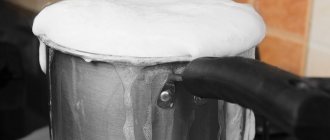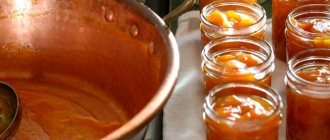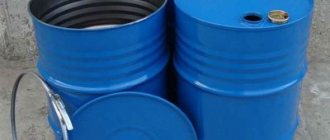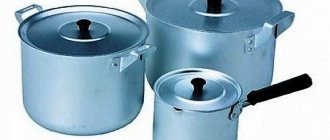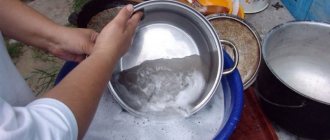Despite the abundance of various preserves, jams and confitures in modern supermarkets, some housewives prefer to make sweet preparations themselves. As cooking utensils, many people prefer to use enamel pans the old fashioned way. They are quite capacious and quite cute, and they are inexpensive.
The process of making jam requires constant attention, because... If you get distracted for a while and forget to stir the boiling mass , soot will immediately form at the bottom. And if you leave it unattended for a long time, then the pan can be hopelessly damaged.
Using simple available tools
There are several proven ways to clean an enamel pan from burnt jam.
The easiest way out in this situation is to try soaking the burnt area with water. The pan needs to be cooled and filled with warm water. Slightly burnt jam will begin to dissolve after 15 minutes. Otherwise, the pan will need to be soaked for several hours. To improve the effect, add two tablespoons of regular detergent or baking soda to the water.
If soaking does not help, try solutions containing one of the following components:
- Salt. Cover the burnt area with salt and leave for 2-3 hours. Then fill the pan with a strong salt solution (about 5-6 tablespoons per 1 liter of water) and boil for an hour.
- Activated carbon. Finely crush the tablets (usually use a 6-liter package) and sprinkle the resulting powder onto the burnt areas. Leave in this form for 30-40 minutes, then add cold water and leave again for half an hour.
- Apple peel. Its properties are similar to citric acid. Peel the apples (preferably sour ones), rub the burnt areas and leave for a while. If the stains have not disappeared, add water, the peels of several apples and boil for an hour.
- Ash. This option is suitable if you are in a summer cottage or in nature. Fill the pan one-third full, add water and, if possible, boil for half an hour.
If the first attempt was not very successful, try repeating the procedure again.
Preventing jam from sticking to an enamel pan
The condition for obtaining a tasty and healthy delicacy is constant stirring. To do this, it is better to use wooden or plastic spatulas for a frying pan with a non-stick coating. Severe burning of sugar impairs the taste of the jam. It becomes bitter. If you wait until the moment of caramelization, the workpiece will be spoiled. It will have to be thrown away.
As soon as the sweet berry or fruit mixture begins to burn, remove it from the heat and pour it into another bowl. Continue to boil, stirring continuously to keep the bottom constantly cooled. On gas and electric stoves with burners, it is convenient to use flame dividers - they distribute heat evenly over the surface. The risk of carbon deposits is reduced.
It is important to control the degree of thickness of the sweet mass. The jam is considered ready if a drop hangs on the blade and does not come off immediately. Another way to check is to place a few drops on a saucer. If the mass holds its shape and does not spread, it’s time to remove the jam from the heat.
Many housewives face the problem of removing dark sweet spots from enamel cookware. Proven cleaning methods will help get rid of this problem. If you handle the enamel carefully, the saucepan will last a long time, and the jam in it will not burn due to microcracks and damage to the coating.
Cleaning a pot with food products
A good effect can be achieved by using one of the following products, which are almost always found in the kitchen:
- Milk serum. Pour a little whey into a saucepan and drain it after a day. Under the influence of the acid contained in the liquid after curdling and straining milk, burnt jam easily comes off the enamel surface.
- Table vinegar. Pour to a level of 1-2 cm, cover with a lid and wait 3-4 hours.
- Lemon. Cut the fruit into two parts, place it on the burnt area and leave for 3 hours.
- Sparkling water. Leave the filled container for half an hour. After this time, try to clean the carbon deposits with a sponge. If this fails, then you need to put the pan on the stove and bring the liquid to a boil.
- Mustard powder. Heat the saturated mustard solution poured into a saucepan and leave to infuse.
Special products to combat severe burning
There are a variety of chemicals available to remove carbon deposits. Most of them are focused on cleaning something outside - stoves, ovens, and are not suitable for cleaning those surfaces that come into contact with food. Therefore, before use, you need to carefully read the instructions and make sure that the drug is approved for use for cleaning dishes. It should also indicate for which coatings it can and cannot be used.
The following industrial preparations are often used to combat carbon deposits:
- "Shumanite." Reliable but aggressive product. Not suitable for all types of surfaces, you need to carefully read the instructions. Has a pungent odor. It removes even heavy carbon deposits in a short time. Liquid product, distributed in a spray bottle.
- "Mr. Cheester." An aggressive product, less effective than Schumanite, but used more economically. Available in liquid form, with a spray.
- Amway. Relatively safe, no pungent odor, non-aggressive product. At the same time, it is less effective and may not cope with large deposits. Available in gel form.
- Comet. A popular cleaning product for removing any stains in the kitchen and bathroom. Available in gel and powder form. Less aggressive, but also less reliable than, for example, Schumanit.
- "Cillit." An effective, powerful gel product. Copes even with old stains.
There are many products, all available in gel (liquid) or powder form. The question arises, which is better. Abrasive cleaning compounds are only suitable for cast iron cookware and stainless steel pans. On other coatings, powders will leave scratches, so preference should be given to gels. Before using this or that composition, you need to make sure that it will not cause harm to the container.
All chemical compositions for getting rid of carbon deposits should be used in a well-ventilated area, without children or pets nearby. Be sure to wear protective gloves and avoid getting the product on your skin or eyes. After cleaning, thoroughly wash and rinse the dishes with clean water and ventilate the room.
Amway
Cillit
Comet
Mr. Chister
Schumann
Use of household chemicals
If your kitchen has a dishwasher, you can use Finish tablets . To do this, pour water into the burnt pan to a level of 2 centimeters and add the tablet. Bring the resulting solution to a boil over very low heat. If the jam is very burnt, cook for about 20 minutes. If not, turn off the heat and cool.
The retail chain offers a wide range of household chemicals intended for cleaning dishes from carbon deposits. It is worth paying attention to the following:
- "White";
- "Shumanite";
- "Mister Muscle";
- "Sanita - gel";
- "Comet" (gel);
- "Cillit Bang".
Before use, you must read the instructions in order to know in what proportions to use the dish cleaner without harming the enamel. You should not forget about your safety and wear rubber gloves while working to protect your hands from exposure to chemicals.
Important : do not use sink and toilet cleaners that contain hydrochloric acid, because If the dishes are not washed properly after processing, the acid may get into the food.
No matter how you try to save your pan from burning, after any manipulation, be sure to thoroughly rinse and rinse it to completely remove any remaining cleaning products. This is especially true for chemicals. It is necessary to rinse using a sponge with a drop of any dishwashing detergent. For greater safety, after using purchased products, it is better to boil water in a cleaned pan to eliminate the possibility of poisoning.
Preparatory work
Usually, fresh, mild soot can be cleaned without problems immediately after cooking and transferring the jam into jars. It is easily washed off with clean water, dishwashing detergent, and a foam sponge. If this doesn’t work, the jam is too burnt, soaking will help.
This method is suitable for all types of pans. But how to soak correctly? To do this, fill the container with warm water with the addition of a small amount of cleaning agent and let it stand for several hours. The water should be exactly warm. Boiling water can promote more intensive adhesion of carbon deposits, while cold water will most likely not cope with the task. In a few hours, the carbon deposits will soften, after which it can be easily wiped off with a simple sponge and dishwashing liquid.
The container should be filled soon after preparing the jam, before the soot has time to turn into a crust. But the pan should not be hot; the temperature contrast can damage the coating. The same thing will happen if you immediately place a hot, burnt pan under cold water or, conversely, fill it with hot water if it has been brought in from the cold. We are talking primarily about ceramic-coated pots and enamel cookware. Therefore, no matter how badly the container burns, it should be cooled to room temperature and only then cleaned.
Soaking can be done using a dishwasher. But you shouldn’t immediately put a burnt pan in it. You must first soak it with regular dishwashing gel so that at least most of the carbon deposits come off.
After making jam, there may be a burn on the pan
Preparation of a special solution
If, after using all the simple techniques, you have not achieved the desired result, you should try a more labor-intensive method on how to clean the pan from burnt jam.
You will need 73% laundry soap and PVA glue. In combination, these two components can help even in the most seemingly hopeless case.
First, prepare the solution in the following proportions:
- 4 liters of boiling water;
- 1/3 laundry soap (shaved into shavings);
- 1 tablespoon PVA glue.
If only the bottom is damaged by the jam, pour the solution into the pan. If you need to clean it entirely, then pour the solution into a large container and place the pan in it. Bring to a boil and simmer for 30 minutes. After this procedure, not only the burnt jam will come off, but also the oldest dirt.
Instead of laundry soap, you can use soda, the effect will be the same .
What methods don't work?
In order not to cause harm to any pan when looking for ways to clean it at home, you should follow simple rules. Namely, to know what you should never do. These methods not only do not work, but can also be dangerous for dishes and human health:
- You should not try to pick out carbon deposits with a fork, knife, or any other sharp object. Whatever the coating of the cookware, such items will cause damage to it. Scratches damage the top layer, metal compounds are released from below and enter food, causing harm to health. Scratches contribute to further destruction of the dishes, food sticks to them, as a result, it is better to throw away the pan rather than continue to use it.
- Do not use products containing chlorine or ammonia to clean dishes used for cooking. They can leave unsightly stains on stainless steel that cannot be removed. It is also quite difficult to wash off the product completely after use. If particles of the substance get into food, it will be harmful to health.
- You can find recommendations for using diluted products to remove blockages in pipes for cleaning pots and pans. It is highly undesirable to do this. There is no guarantee that the method will work; however, such preparations are toxic; they, unlike gels and powders for cleaning ovens and microwaves, are not intended for proximity to food products. May cause harm to health even during the cleaning process (vapors are toxic).
If there are doubts whether the chosen product (whether industrial or household) will harm the dishes, it makes sense to try it on a small area of the coating.
You can remove burnt jam from the bottom of an enamel or any other pan using many simple means available. At the same time, we should not forget about the safety for the dishes and for the health of those who will then eat from these dishes. And, of course, it is easier to prevent food from sticking than to scrub the vessel later. Cooking jam is a process that requires the constant presence of a cook. Without proper attention, it quickly sticks and “runs away.” Therefore, you need to observe the temperature regime, as well as regularly stir the berry treat.
Cleaning from dark plaque
Over time, enamel cookware tends to become covered with a dark coating. This is especially helpful when cooking vegetables, for example, for vinaigrette. After a few months, you will notice that your pan has lost its original snow-white appearance. We share cleaning tips for removing dark plaque.
Method one
Dishes can be cleaned with baking soda. “Dry” or boil the pan with a solution of soda for 30 minutes, as recommended above. You can use two other, more effective methods using bleaching agents.
Method two
The “Whiteness” product, familiar to many, helps remove plaque without much effort. Pour water into the pan so that it covers the entire surface where there is plaque. Add “Belizna” to the water (2-3 tablespoons per 1 liter of water) and leave to stand for about a day. A significant part of the plaque will definitely go away. A necessary condition is that after the procedure with “Whiteness”, boil a pan of clean water twice to avoid chemical poisoning and remove odor.
Method three
2 tablespoons of dry bleach will do the trick, but only through the boiling process. Add bleach to a saucepan filled with water, bring to a boil and let simmer for about 3 minutes. After which it is enough to drain the water and make sure that all plaque has disappeared. Do not forget to thoroughly rinse the surface with plenty of water and be sure to boil it 1-2 times with clean water to completely remove the chemical.
If you want to change your enamel cookware to stainless steel cookware. Then we offer you an article on how to choose stainless steel cookware and not fall for the manufacturers’ tricks.
Cast iron cookware
Cleaning such a container will not be difficult. It is best to process cast iron products while they are still warm. At this temperature, dishes are easier to clean.
To remove jam deposits from this type of cookware, no additional special products are required. You can use ordinary powdered cleaning products, as well as any acids and alkalis. For a more vibrant effect, soak should be used.
First aid
Of course, it is best to remove burnt jam immediately after cooking. If you put it off until later, you will have to work hard with your hands, scraping out the remains, and move on to radical cleaning methods.
What should you do immediately after discovering a problem? I found 2 different ways for myself.
Method 1 . We take the largest pan in the house (so that the burnt one can fit in it) and pour water into it, put it on the fire. When the water warms up a little, add half a package of baking soda or technical soda, as well as a small tube of silicate glue (yes, that’s what it is). Don’t even think about adding super glue or PVA, only the silicate version! Mix the resulting mass until smooth and boil. As a result, we should end up with something like a paste. Place the burnt vessel in a pan with the product and cook for about 20 minutes. Then remove it and quickly place it under cool water, simultaneously removing the paste with a soft sponge. Voila, the miracle product pulled out all the burnt marks and made the pan clean.
Method 2 . It's also very effective. Immediately after removing the burnt pan from the stove, place it under running water and remove the thick layer of burnt marks (let the black spots and traces of scale remain). Next, pour water into the pan and add 2 tablespoons of citric acid, put the product on the fire. As the temperature rises, you will see the remaining scraps moving away from the bottom. All that remains is to drain the lemon water and wipe the sponge with cleaning powder (or soda) and a soft sponge until the surface is perfectly smooth.
How to clean burnt jam from an aluminum pan
It is not recommended to use an aluminum container for making jam. This is the most difficult part to remove burnt from. The most effective remedy for this purpose is citric acid. Fill the dishes with lemon solution so that it covers the bottom by 2 cm. Prepare the solution at the rate of 1 teaspoon of the main component per 1 liter of water. Bring the liquid to a boil, then cool. The sugar film will peel off from the walls of the container on its own; as soon as this happens, rinse it with running water.
Aluminum cookware
To avoid damaging the outer layer of metal, do not use abrasive materials to clean the aluminum container.
- Initially, you need to try to clean the burnt jam using the soaking method mentioned above. To achieve the desired result, the duration of the procedure can be increased to several hours. If this method does not help, and the jam is completely burnt, move on to other steps.
- Citric acid can soften burnt sugar. If the carbon deposits are evenly distributed over the entire inner surface of the basin, fill it with warm water. Add citric acid at the rate of one teaspoon per liter of water. Boil the resulting solution for fifteen minutes. Make sure the brown crust comes off. Then wash the dishes in cool water. If sugar deposits only cover the bottom of the pan, then using this method, a little cleaning solution is enough to immerse the burnt area in it.
- To get rid of burnt jam on aluminum cookware, you can also use a mixture prepared from one liter of water, a tablespoon of silicate glue and a small amount of baking soda. The resulting solution must be poured into the container to be cleaned, heated and maintained in a boiling state for about half an hour. Once the container is completely clean, it can be cooled and washed as usual.
- If you have laundry soap, you can grind it on a coarse grater. The resulting shavings must be mixed with silicate glue. Rub the contaminated areas of the dishes with this mixture, leave the mixture on the carbon stains for several minutes, then rinse thoroughly with warm water.
Advice! To protect the skin of your hands from exposure to chemicals and mechanical damage when handling dishes, wear protective gloves.
Why choose enamel cookware?
Enamel cookware is widely known and has been used for 180 years. Even with the advent of microwave ovens and other smart appliances, it has not lost its relevance and popularity. It is made from different types of metal, which is coated with enamel during processing.
Housewives traditionally use enamel-coated pans to make jam.
The undeniable advantages of such dishes:
- The safety of cooked food is ensured by the enamel coating;
- durability of use when handled correctly;
- enamel stability in acidic and alkaline environments is important for product selection;
- ease of care;
- a wide choice of design, style, color to decorate any kitchen;
- The affordable price ensures wide distribution.
Removing carbon deposits or burnt sugar from stainless steel cookware
A characteristic feature of stainless steel cookware is its thick bottom, so it is more suitable for making jam. But, if trouble could not be avoided, then carbon deposits can be removed in a simple way.
- Fill the bottom of the pan with boiling water.
- Add a small amount of vinegar and salt to it.
- Close the container with a lid and put it out of the reach of children.
- After 12 hours, wash it with detergent or baby soap.
Attention.
If you cannot get rid of the stain the first time, do not try to scrub it off with a hard sponge. This will lead to scratches that will subsequently be impossible to get rid of.
Cleaning methods with folk remedies
Grandmother’s methods do not lose their relevance if you don’t have professional ingredients for caring for kitchen utensils at hand. You can use proven products that can be found in any housewife’s kitchen:
- table vinegar;
- baking soda;
- citric acid;
- potato peels;
- apple peel;
- laundry soap;
- Activated carbon.
Women manage to clean pots even with the help of Coca-Cola, which is in the refrigerator.
Table vinegar
Vinegar or dilute acetic acid reacts chemically and eats away the carbon deposits. After this it can be easily removed. To do this, just boil the vinegar solution in a contaminated container.
The proportion of the solution for boiling should be 1/1.
In addition, vinegar quickly removes unpleasant odors in the kitchen.
Baking soda
Baking soda is more than just a leavening agent for dough. It reacts chemically with any food particles and makes them softer. Therefore, it is used to soften any hardened contents. Sodium bicarbonate is indispensable as a disintegrant for soot.
Lemon acid
Citric acid is a good solvent for various food particles. It can be replaced with lemon juice and apple peels, which create an acidic environment.
Boil the apple peelings in a burnt saucepan and then remove the soot layer with a soft sponge. If the pan is very dirty, boil potato peels and apple peels alternately.
Laundry soap
If you grate laundry soap and dilute it with hot water, you will get a universal alkaline solution that can be used to pour over burnt dishes. Boil water and soap for 10-15 minutes, allow the liquid to cool and remove carbon deposits with a soft sponge.
This way, at home, you can get rid of old grease deposits near the handles of pots and on the backs of plates, which are difficult to clean during everyday washing. Boil the dishes in soapy water and your kitchen utensils will sparkle clean.
PVA glue
If the dishes are heavily soiled, use a time-tested composition of soda, laundry soap and glue. Pour water into a large container, heat it almost to a boil and add these ingredients. When the soap is dissolved in boiling water, kitchen utensils, including burner lids, are placed in it. All this is enough to boil over low heat for 15 minutes. After this, allow the container to cool to room temperature and rinse in running water.
Instead of PVA, you can use silicate glue.
This procedure must be carried out with the windows open or the hood turned on. The solution has a specific smell.
Activated carbon
The coal is ground into powder and poured into the bottom of the pan. Then add a little water to start the cleansing reaction. After half an hour, wash with a sponge and liquid dish soap.
Carbonated drinks
Coca-Cola, Fanta and Sprite can be used as an all-purpose detergent. They contain phosphoric acid, which dissolves not only carbon deposits, grease and rust, but even limescale. Therefore, housewives often use these drinks to maintain cleanliness in the house.
Pour 1 liter of carbonated drink into the burnt pan and leave for 1 hour. After the procedure, it can be easily washed with a soft sponge; unusable food particles will quickly be removed from the walls.
Common Mistakes
Despite all the variety of available methods that do not damage the integrity of the coating of kitchen utensils, you can make a mistake when cleaning the pan from jam. After all, sometimes you really want to use the most effective means in order to save time, but rushing in this matter will only do harm. To avoid grief caused by damage to dishes, you need to know not only the permitted, but also prohibited methods and means. Under no circumstances should you use sharp objects. They leave scratches and destroy the coating. Subsequently, the pan will quickly become unusable.
It would also be a mistake to use products with chlorine and ammonia. These harsh chemicals will not only remove dirt, but also the protective layer of the pan. Means for removing blockages in pipes also have the same negative properties.
In addition, it should be remembered that chemistry is harmful not only to kitchen utensils, but also to the human body. Poisoning is possible even at the stage of washing dishes. Harmful vapors enter through the respiratory tract, causing irreparable damage to health. The most correct solution is to use folk, natural remedies with minimal addition of chemical components.
Why does jam burn?
This kind of problem can happen to anyone. And there are enough reasons for this:
- The basin is made of low-quality material. Cookware purchased in cheap markets is most often made from low-quality alloys that do not distribute heat evenly. Not only does it quickly fail, but it also poses a health hazard.
- Lack of non-stick layer. Older model pans do not contain a protective coating. If possible, purchase a modern example. It will serve you in the kitchen for a long time.
- Remains of dirt at the bottom of the bowl. Sometimes, not paying attention to the fact that the dishes are not completely clean (there are remnants of stuck food or fat from previous cooking in the depths), they add sugar and begin to prepare the syrup. The sweet mass reacts with the waste and is firmly in contact with the bottom.
- Cooking at high temperatures. Sweets should be cooked over low heat, and the burner should be selected in accordance with the size of the dish.
- During the cooking process, you need to stir the mass so that the delicate berries do not settle on the hot bottom. To do this, buy a spatula made of wood or silicone.

